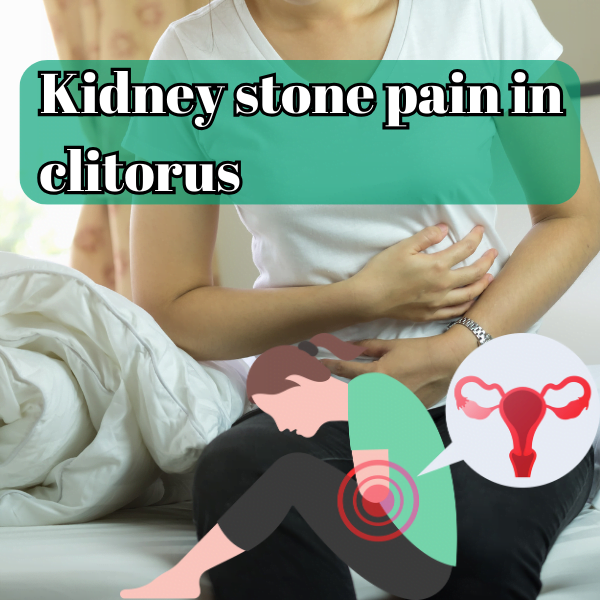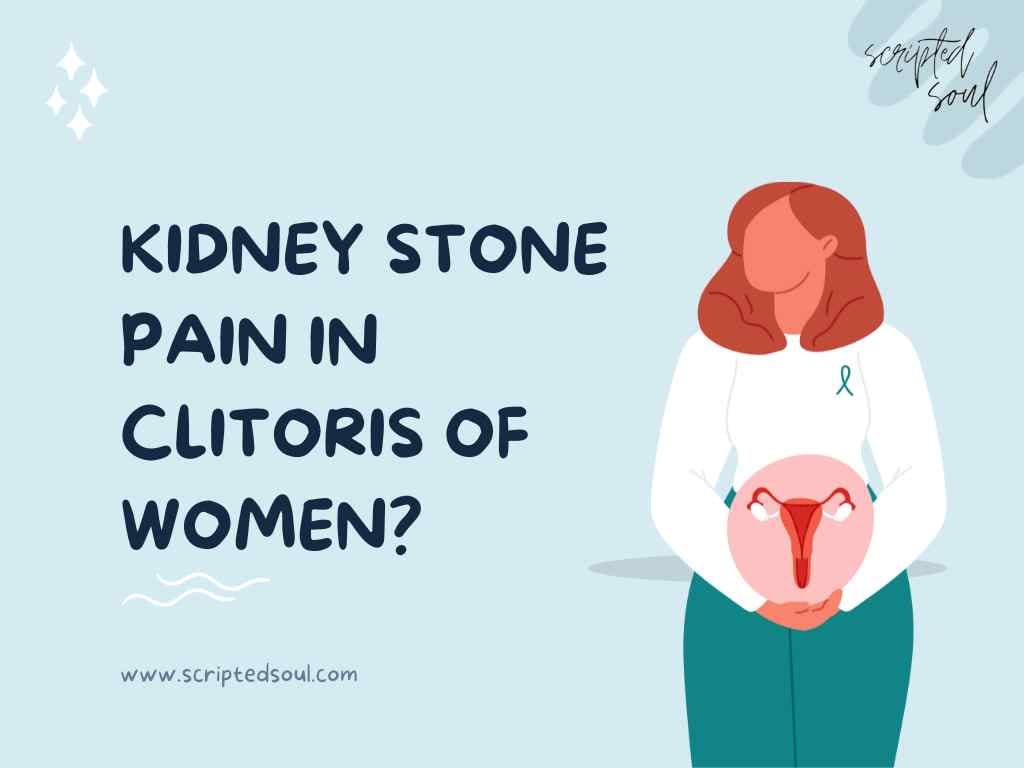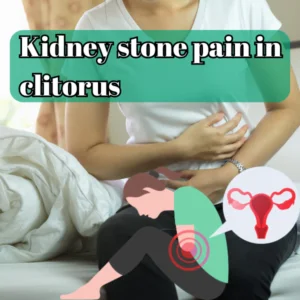Kidney stone pain rarely refers pain to the clitoris. Most kidney stone discomfort is felt in the back, lower abdomen, or groin.
Kidney stones are hard mineral deposits that form inside your kidneys. Experiencing kidney stone pain can be excruciating, typically originating in the back and sides, radiating to the lower abdomen and groin. While the clitoris is an uncommon site for referred kidney stone pain, it’s possible for pain signals to overlap due to the complex network of nerves in the pelvic area.
Understanding this condition is crucial for those seeking relief and guidance, as kidney stones affect many individuals each year. Prompt diagnosis and treatment are essential to alleviate pain, prevent complications, and enhance overall urinary health. It’s important to consult healthcare professionals if you suspect kidney stones, as they can provide personalized care and management options tailored to your specific condition.

Credit: www.bookingforhealth.com
Unraveling The Connection
Many have heard of kidney stones. Few understand their potential impact on places far from the kidneys, like the clitoris.
Kidney stones are hard deposits. They can cause immense pain. This travels in unexpected ways. About the clitoris: it’s sensitive. It has extensive nerve networks. This can make kidney stone pain felt more widely.
Anatomy Of Discomfort: Kidney Stones To Clitoral Pain
Let’s explore how kidney stones link to clitoral pain. Kidneys filter blood. Stones block urine flow. Pain emerges. It doesn’t stay put. Below, find out how body parts connect:
- Kidneys: They form urine.
- Ureters: Tubes carrying urine to the bladder.
- Bladder: Stores urine.
- Nerves: Signals from the kidneys to the brain.
- Clitoris: Rich in nerves, feels more than just touch.
The network of nerves is the culprit here. Pain from kidney stones can radiate. It reaches the pelvic area. This causes clitoral pain.
Physiological Pathways: How Pain Travels
The body has an intricate system. Nerves transmit pain. This system doesn’t acknowledge boundaries. Kidney stone pain can be felt as clitoral pain. Here’s how:
| Step | Process |
|---|---|
| 1 | Kidney stones cause pressure. |
| 2 | Nerve endings pick up pain signals. |
| 3 | Signals move to the spinal cord. |
| 4 | Pain travels along the nerves. |
| 5 | The pelvis and clitoris receive the pain. |
Remember, referred pain is common here. That means the pain is felt somewhere other than its source. Kidney stone pain manifests in the clitoral area. This is due to shared nerve pathways.

Credit: medium.com
Symptom Snapshot
Welcome to our ‘Symptom Snapshot’ series, where we delve into the not-often discussed topic of kidney stone pain manifesting in the clitoris. This unique and distressing symptom can be both confusing and alarming for those experiencing it. Today we’re zeroing in on what this pain feels like and how to distinguish it from other conditions.
Identifying Kidney Stone-induced Clitoral Pain
Understanding kidney stone-induced clitoral pain is crucial for timely recognition and treatment. Typically, kidney stone pain starts in the back or lower abdomen. It can travel to the groin and, less commonly, to the clitoral area. Here are key symptoms to watch for:
- Sudden, severe pain that comes in waves.
- A sharp, stabbing sensation in the lower abdomen or pelvic region.
- Possible accompanying symptoms like nausea or painful urination.
The pain may intensify during physical movement or when you try to find a comfortable position.
Differentiating Symptoms From Other Conditions
Pain in the clitoral area can stem from various causes, so it’s critical to differentiate between them. Here’s how kidney stone pain compares:
| Kidney Stone Pain | Other Conditions |
|---|---|
| Often starts in back or side. | Typically localized without back pain. |
| Waves of pain, fluctuating intensity. | Constant, steady pain or discomfort. |
| Can co-occur with urinary symptoms. | May be associated with menstrual cycle or infections. |
Note the timing, quality, and the ebb and flow of pain intensity. These factors are keys to recognizing kidney stone pain. Always consult a healthcare provider for an accurate diagnosis and appropriate treatment.
Immediate Reliefs
Immediate reliefs from kidney stone pain are essential for comfort. Kidney stone pain can strike hard, reaching far beyond its origins. Even in areas like the clitoris, pain might be felt due to the nerve connections. Finding ways to ease the discomfort becomes a top priority.
Home Remedies To Ease The Discomfort
Soothing kidney stone pain at home is possible with simple remedies:
- Stay Hydrated: Drink plenty of water to help stones pass.
- Warm Baths: Relax in a warm bath to reduce pain sensations.
- Lemon Juice: The citrate in lemon juice can break down stones.
- Heating Pads: Apply to affected areas to alleviate pain.
Pain Management: Over-the-counter Options
Over-the-counter medicines offer quick pain relief. Consider these options:
- NSAIDs: Nonsteroidal anti-inflammatory drugs reduce inflammation and pain.
- Acetaminophen: This can relieve pain but won’t reduce inflammation.
- Antispasmodics: These may lessen muscle spasms in the urinary tract.
Always consult a doctor before starting any medication.
Medical Interventions
Kidney stone pain can be very sharp and may sometimes radiate to unexpected areas like the clitoris. This pain indicates the need for medical intervention. Taking the right steps at the right time can reduce discomfort and prevent complications.
Seeking Professional Help: When To Visit A Doctor
Notice changes in your body and act promptly. See a doctor for:
- Sudden, severe pain that doesn’t go away.
- Pain accompanied by nausea or vomiting.
- Blood in your urine.
- Fever and chills, suggesting an infection.
- An urgent need to urinate more often.
When you experience these symptoms, it signals something’s not right. Don’t hesitate to seek medical advice.
Treatment Choices: Pharmaceuticals And Procedures
Different treatments exist for kidney stone pain in the clitoris. Your doctor may suggest:
- Pain relievers to manage discomfort.
- Medications that help pass stones smoother.
For larger stones or persistent pain, medical procedures might be necessary. These may include:
| Procedure | Description | Recovery Time |
|---|---|---|
| Extracorporeal Shock Wave Lithotripsy (ESWL) | Sound waves break stones into smaller pieces. | A few days to a week. |
| Ureteroscopy | A small scope removes stones or breaks them up. | Generally short, possibly same-day discharge. |
| Percutaneous Nephrolithotomy | Large stones removed through a small back incision. | A few weeks for complete recovery. |
Discuss all options with your healthcare provider. Choose what best fits your situation.
Dietary Adjustments
Managing what you eat plays a big role in tackling kidney stones. Pain can often hit hard and unexpectedly. This includes the rare but distressing pain from kidney stones felt in the clitoris. Certain foods can help or worsen the condition. Let’s look at what to eat and what to avoid to keep kidney stones at bay.
Foods To Favor And Avoid With Kidney Stones
Choosing the right food is crucial for preventing kidney stones. Stones form when certain substances like calcium, oxalate, or uric acid build up. A correct diet can lower these levels. Here’s a breakdown:
| Foods to Favor | Foods to Avoid |
|---|---|
|
|
Hydration: Key To Preventing Stone Formation
Drink plenty of water every day. It is by far the simplest step to reduce the risk of kidney stones. Water helps to dissolve the minerals and salts that can form stones. Aim for clear or light-yellow urine as a sign of good hydration.
- Drink at least 8-10 glasses of water daily.
- Include beverages that help hydration like herbal tea.
- Lemonade and orange juice are great too; they contain citrate that helps prevent stones.
- Avoid soda, especially those with high fructose corn syrup.
Holistic Approaches
Kidney stone pain can be sharp and sudden. It often strikes without warning. The pain may spread to different areas, including the clitorus. Many seek holistic methods to ease this discomfort. Holistic approaches consider the whole person. They use natural ways to promote healing and pain relief. Let’s explore some of these gentle, yet effective techniques.
Stress Reduction Techniques
Stress can make pain worse. Learning to manage stress is important. Here are some ways:
- Deep breathing exercises help relax your body.
- Yoga joins body movements with breath work to reduce stress.
- Guided imagery uses calming images to focus and calm your mind.
- Meditation promotes inner peace and can distract from pain.
Beneficial Body Positions For Pain Relief
Finding a comfortable position helps relieve kidney stone pain. Consider these positions:
- Lie down with a cushion under your knees.
- Try fetal position with a pillow between your knees.
- Sit in a reclined chair with a heating pad on your back.
Remember, everyone is different. Keep trying until you find what works for you. Pain relief is possible with patience and gentle care.
Preventive Measures
Kidney stone pain can be extremely uncomfortable. It may even reach the clitoral area in some cases, causing distress. Understanding and implementing preventive measures can play a crucial role in reducing the risk of kidney stones. Let’s explore practical steps under the following subtopics.
Lifestyle Changes For Long-term Health
Long-term health starts with daily habits. Here are key lifestyle changes that can help prevent kidney stones:
- Stay Hydrated: Drink plenty of water throughout the day.
- Limit Salt Intake: High sodium levels can increase stone risk.
- Consume Calcium-Rich Foods: Dairy and leafy greens are great choices.
- Moderate Protein: Balance your meat and vegetable protein consumption.
Regular Health Screenings And Monitoring
Keep track of your health with routine screenings. Detect and address issues early:
- Annual Check-ups: Visit your doctor yearly or as recommended.
- Urine Tests: Check for signs of stone formation regularly.
- Blood Tests: Monitor calcium and uric acid levels.

Credit: www.researchgate.net
Navigating Emotional Impacts
Kidney stone pain can strike anywhere, even in unexpected areas like the clitoris. This physical discomfort brings along a heavy emotional toll. The journey to manage and understand these emotions is vital for healing. Explore strategies for coping and getting support through this trying time.
Coping Mechanisms For Chronic Pain
Living with chronic pain from kidney stones is a tough battle. True comfort often lies in effective coping strategies. Here’s how to cope:
- Breathe deeply – Use breathing exercises to ease pain.
- Stay active – Light exercises can distract from discomfort.
- Mindfulness – Meditation helps focus your mind away from pain.
- Warm baths – They may provide relief for pelvic pain.
- Regular check-ins – Monitor pain levels and triggers.
Remember to consult a doctor for tailored advice.
Support Systems: Finding Community And Counseling
No one should face pain alone. Building a support system is key to emotional well-being. See how you can connect:
- Join support groups – Share experiences with those who understand.
- Seek professional counseling – Therapists can help you navigate your feelings.
- Reach out to loved ones – Family and friends offer comfort and support.
- Connect online – Online communities provide 24/7 solidarity.
Future Innovations
Kidney stone pain can sometimes radiate to unforeseen areas, including the clitoris. This puzzling and intense discomfort leads experts to continuously seek better solutions and relief methods for sufferers. Anticipated future innovations promise to bring hope and alleviate pain for those impacted by this severe condition.
Emerging Treatments On The Horizon
The medical community is buzzing with excitement over new treatments for kidney stone pain. On the horizon, we might see:
- Non-invasive technologies that break down stones without surgery.
- Enhanced lithotripsy techniques, targeting stones with precision and less discomfort.
- Biological treatments designed to prevent stone formation at a molecular level.
Advancements In Pain Management Research
Significant strides in pain management offer a beacon of hope:
- Studies on nerve signal blocking may provide targeted relief without medication.
- New analgesic drugs are in development for more effective pain control.
- Smart drug delivery systems ensure pain relief precisely when and where it’s needed.
Frequently Asked Questions
Where Does A Woman Hurt With Kidney Stones?
A woman with kidney stones may experience pain in the lower back, sides, abdomen, or groin area. Pain intensity can vary from mild to severe.
How Do You Know If A Kidney Stone Is Stuck In Your Urethra?
Signs that a kidney stone is stuck in your urethra include sharp, severe pain, difficulty urinating, and blood in the urine. Noticeable discomfort while urinating often accompanies these symptoms.
How Do You Know When A Kidney Stone Is Close To Passing?
You may feel the kidney stone moving through your urinary tract, accompanied by pain or burning during urination. Before passing, intense, though brief, waves of sharp pain may occur in your back, side, or lower abdomen. Increased urination frequency can also signal that a stone is nearing exit.
Does Kidney Stone Hurt Going Through Urethra?
Passing kidney stones can be painful, especially when moving through the narrow urethra. Users often experience sharp, intense discomfort during this process.
Conclusion
Understanding kidney stone pain when it presents in unexpected areas, like the clitoris, emphasizes the body’s interconnected pain response. Consult a healthcare provider for tailored advice and treatment options. Remembering key symptoms can lead to early detection, reducing the duration and severity of discomfort caused by kidney stones.
Stay informed and proactive about your urological health for prompt relief and recovery.

